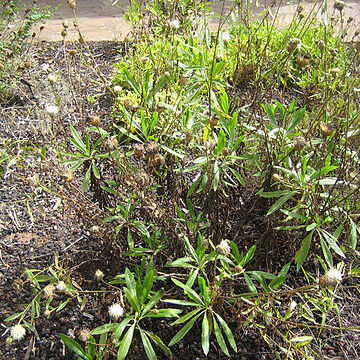Herbs, annual or perennial, usually with branched or unbranched, crisped, septate hairs, often with red-brown interstipular and intersepaline glands. Leaves: basal leaves oblanceolate to orbicular; cauline leaves opposite or apparently whorled; apices setose; stipules, free, persistent, scarious. Inflorescence a dichasial cyme, open or compact, terminal or axillary; bracts similar to stipules. Flowers 5-merous, bisexual. Sepals free or basally adnate to stamens, scarious, lanceolate to rarely ovate, acute to attenuate, entire to laciniate, usually glabrous. Petals free or basally adnate to stamens (staminodes), membranous. Stamens 5, antisepalous; anthers dorsifixed, versatile; staminodes sometimes present, antipetalous, minute. Ovary unilocular, shortly stipitate; style 1; stigma 3-lobed or apparently capitate. Capsule 3-valved. Seeds 1–many, not keeled or winged.
Annual, biennial or perennial herbs, rarely suffruticose; stems usually erect, branched, glabrous or pubescent. Leaves opposite or whorled; sessile at swollen nodes; stipules conspicuous, scarious; blade usually linear-subulate or lanceolate, rarely elliptical or spathulate. Inflorescences terminal dichasial cymes, often contracted or capitate; bracts scarious. Sepals 4-5, free, scarious or rarely herbaceous with scarious margin; petals 4-5, entire or dentate, shorter than sepals; fertile stamens 4-5, staminodes 4-5, filaments free or connate at base; ovary ovoid, sessile or shortly stipitate, 1-locular, ovules few, campylotropous on basal placenta, style 3-fid, 3-dentate, or capitate and 3-sulcate. Fruit a 3-valved capsule, ovoid or ellipsoid; seeds 1-few, cochleate, oblong or reniform, smooth or tuberculate.
Annual or perennial, usually pubescent, erect or prostrate herbs. Leaves opposite or verticillate, usually linear and sessile at the swollen nodes, with con-spicuous scarious stipules. Flowers in terminal dichasial cymes, white or reddish. Sepals 4-5, occasionally biseriate. Petals 4-5, shorter than the sepals, entire or toothed. Stamens 4-5, the anthers versatile, the flattened hypogynous filaments slightly connate below. Ovary superior, unilocular, carpels usually 3; styles united below, the stigmata subcapitate; ovules few, campylotropous on basal placentae. Capsule ovoid to ellipsoid, dehiscing longitudinally into 2-3 entire valves; seeds 1-few, cochleate, tuberculate, the embryo curved about the perisperm.
Annual or perennial herbs. Stems erect or ascending, often richly branched, sometimes lignified at the base. Leaves stipulate, small, opposite or pseudoverticillate in lower part. Stipules scarious. Inflorescences terminal, dense or lax. Flowers small, bisexual, sometimes perigynous; the bracts scarious. Sepals entirely scarious, white, not carinate. Staminodes often present, usually minute. Petals 5, entire, emarginate or denticulate. Stamens 5 (sometimes fewer), filaments inserted below a disc. Ovary unilocular, ovules few to many; style short or long, filiform, stigma shortly trilobed, capitate or indistinct. Fruit a capsule dehiscing by 3 valves. Seeds tiny, reniform, translucent.
Annual or perennial plants, mostly herbaceous but sometimes woody near the base. Stems erect or ascending, often much branched. Leaves linear or oblanceolate to ovate, opposite or apparently whorled, with scarious stipules. Inflorescences in terminal, loose or compacted, cymes. Flowers 5-merous; perianth and stamens hypogynous or somewhat perigynous. Sepals entirely scarious, not keeled, white or brown to purple. Petals shorter than the sepals. Stamens 5 (or reduced from 5). Ovary unilocular with few to many ovules; style with three short lobes or capitate. Capsule 3-valved.
Herbs or subshrubs, annual or perennial. Stems erect or diffuse. Leaves opposite or falsely verticillate with axillary clusters of leaves, sessile or petiolate; leaf blade linear to obovate; stipules membranous or hyaline. Inflorescence a cyme, terminal. Flowers numerous, 5-merous. Sepals hyaline, midvein not raised. Petals usually small, entire or 2-lobed. Stamens (2--)5. Ovary 1-loculed with few to many ovules; style undivided at apex. Fruit a capsule, 3-valved, few to several seeded. Seeds reniform, slightly flat.
Annual or perennial herbs, sometimes somewhat woody near the base; stems ascending or spreading, sometimes much branched.
Stamens 5 or fewer by abortion; filaments free or slightly connate at the base, sometimes with a ring of five staminodes.
Leaves opposite or apparently whorled, linear to oblanceolate or ovate; stipules scarious.
Ovary 1-locular; ovules few to ?; style with 3 short stigmatic arms or capitate.
Sepals 5, scarious, not keeled, silvery, brownish, purple or pinkish.
Inflorescences of loose or compact terminal cymes; bracts scarious.
Petals 5, shorter than the sepals, entire or emarginate.
Perianth and stamens hypogynous or somewhat perigynous.
Capsule 3-valved.

